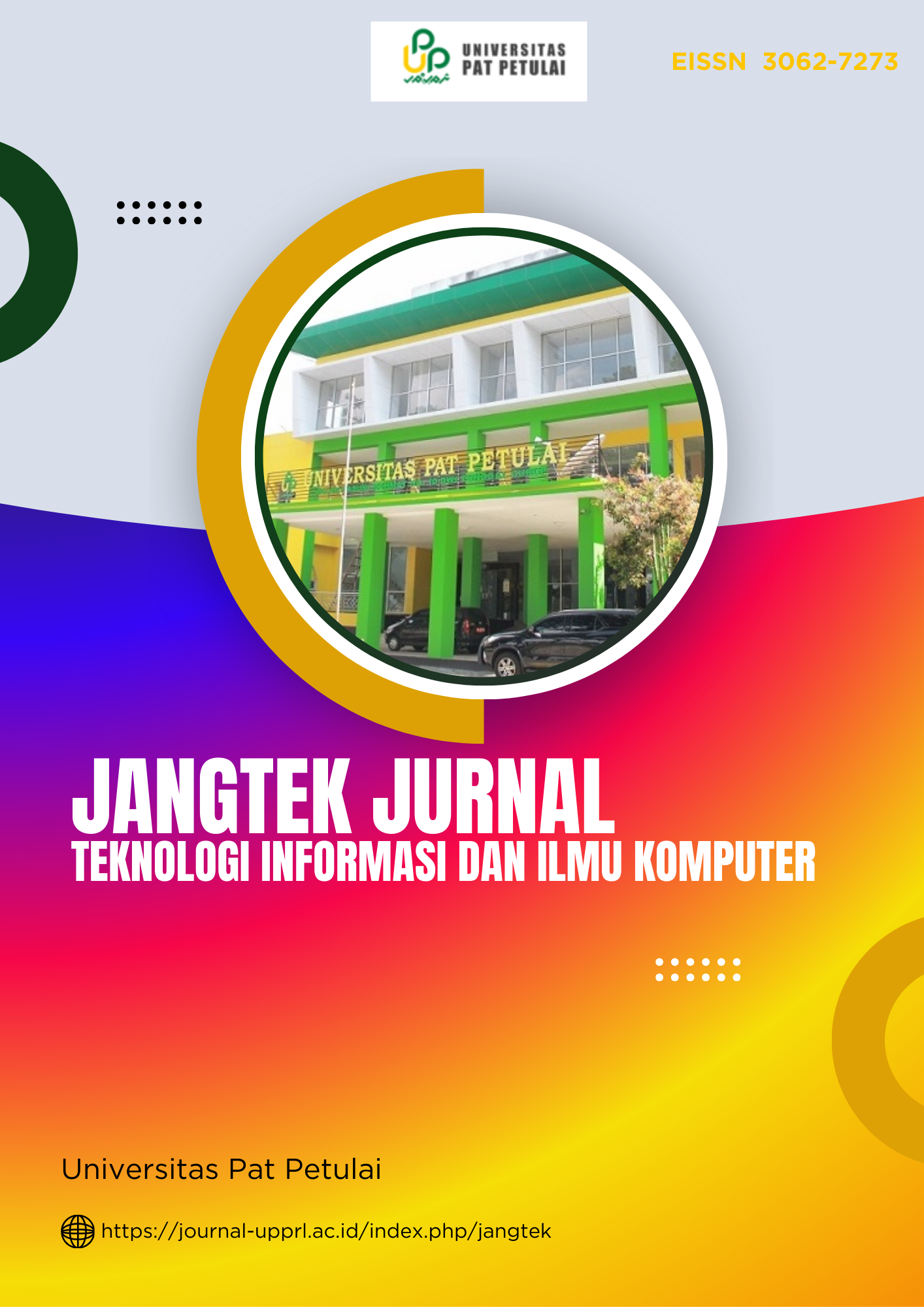Geographic Information System (GIS) Design Web-Based Mapping Of Riminality Prone Areas In Rejang Lebong District
Keywords:
Sistem Informasi Geografis, Pemetaan, Kriminalitas, Web, Kabupaten Rejang LebongAbstract
This research focuses on designing and developing a web-based Geographic Information System (GIS) for mapping crime-prone areas in Rejang Lebong Regency. The main aim of this system is to overcome the lack of information about crime-prone areas in Rejang Lebong Regency. This research was conducted in Rejang Lebong Regency with a research methodology using a mixed qualitative and quantitative approach and using the Spiral Model in software development methods. Data collection methods were carried out by interviews, study of documents from the police and other sources, and observation. Data processing uses XAMPP software using Visual Studio Code as the source code editor and using the PHP MySQL programming language, and using Google Maps as mapping. The data is analyzed to identify, which is then visualized in a map and tested for functionality using Black Box Testing. The result of this research is a GIS web application that is user-friendly and can be accessed by the public from various groups and authorities. This system is expected to increase public awareness, assist in planning security strategies, and support data-based decision-making processes. This research only maps location points.
References
Alkhalidi, M. W., Nadeak, B., & Sayuthi, M. (2020). Sistem informasi geografis pemetaan wilayah penyalahgunaan narkoba mengunakan metode SOM (Self-Organizing Map) studi kasus: kabupaten aceh tenggara. Building of Informatics, Technology and Science (BITS), 2(1), 1-9.
Bady, N., Elsayed, T., & El-Seoud, S. A. (2020). UML Based Dynamic Web Service Discovery and Composition. International Journal of Computer Applications, 175(20), 39-44.
Boehm, B. (2018). Spiral Model Overview. Diakses dari https://resources.sei.cmu.edu/library/asset-view.cfm?assetid=508396
Bowen, G. A. (2019). Document Analysis as a Qualitative Research Method. Qualitative Research Journal, 19(2), 142-159.
Bowen, G. A. (2019). Document Analysis as a Qualitative Research Method. Qualitative Research Journal, 19(2), 142-159.
Daerah rawan kriminalitas di kab RL. https://bengkulu.antaranews.com/berita/244553/polres-rejang-lebong-siapkan-pengawalan-kendaraan-di-daerah-rawan-kejahatan
Dennis, A., Wixom, B. H., & Roth, R. M. (2021). Systems analysis and design. John Wiley & Sons.
Gao, J., Li, M., Zhang, L., & Jiang, H. (2021). Black Box Testing for Mobile Apps: A Systematic Literature Review. IEEE Access, 9, 49757-49770.
Google. (2021). Google Maps: Explore the World. Diakses dari https://www.google.com/maps/about/
Hariman, A., Santoso, H. B., Sembiring, R. W., & Wiyono, B. (2020). Flowchart-Based Visual Programming Environment for Low-Code Software Development. International Journal of Electrical and Computer Engineering (IJECE), 10(4), 4476-4483.
Herlinda, A., & Riyati, T. T. (2020). Sistem Informasi Geografis Pemetaan Daerah Rawan Kecelakaan Wilayah Kota Banda Aceh. Journal Of Informatics And Computer Science, 6(1).
Islamiati, D. (2023). Sistem Informasi Geografis Pemetaan Daerah Pariwisata. JSiI (Jurnal Sistem Informasi), 10(1), 98-102.
Johnson, A., Smith, B., & Brown, C. (2022). XAMPP: A Comprehensive Tool for Local Web Development. Journal of Web Development, 10(2), 45-58.
Kyrnin, J. (2021). Creating Web Pages For Dummies. Wiley.
Laudon, K. C., & Laudon, J. P. (2021). Management Information Systems: Managing the Digital Firm. Pearson.
Li, J., Dragicevic, S., & Veenendaal, B. (2021). Geographic Information Systems: Principles, Techniques, Applications, and Management. CRC Press.
Pressman, R. S. (2022). Software Engineering: A Practitioner's Approach. McGraw-Hill Education.
Rubin, H. J., & Rubin, I. S. (2020). Qualitative Interviewing: The Art of Hearing Data. Sage Publications.
Syahputra, E., Widiartha, I. B. K., & Zubaidi, A. (2019). Rancang Bangun Sistem Informasi Geografis Pemetaan Daerah Rawan Kriminalitas Dikota Mataram Berbasis Web. Jurnal Manajemen Informatika dan Sistem Informasi, 2(2), 39-46.
United Nations Office on Drugs and Crime (UNODC). (2019). Global Study on Homicide. Retrieved from https://www.unodc.org/documents/data-and-analysis/gsh/Booklet1.pdf
Wazir, M., Khan, M. A., Hameed, Z., & Anwar, M. (2021). An Approach to Derive Use Case Diagrams from Software Requirements Specification Document. Journal of Software: Evolution and Process, 33(5), e2354.
Welling, L., & Thomson, L. (2020). PHP and MySQL for Dynamic Web Sites. Peachpit Press.
Yuliansyah, C., & Wijaya, H. O. L. (2021). Pemetaan Persebaran Fasilitas Umum Berbasis Sistem Informasi Geografis (Studi Kasus Di Propinsi Bengkulu). Technologia: Jurnal Ilmiah, 12(4), 228-233.
Zaytsev, V., Canfora, G., & Panichella, A. (2021). Understanding the Usage of Visual Studio Code Extensions. Empirical Software Engineering, 26(2), 1-35.
Downloads
Published
Issue
Section
License
Copyright (c) 2025 Septi Nurjana, Chandra Yuliansyah, Nurfitri Andayani, Murlena (Author)

This work is licensed under a Creative Commons Attribution-NonCommercial-ShareAlike 4.0 International License.
Authors who publish with JANGTEK JURNAL : Teknologi Informasi dan Ilmu Komputer agree to the following terms:
- Authors retain copyright and grant the journal right of first publication with the work simultaneously licensed under a Creative Commons Attribution-NonCommercial-ShareAlike 4.0 International License (CC BY-NC-SA 4.0) that allows others to share the work with an acknowledgment of the work's authorship and initial publication in this journal.
- Authors are able to enter into separate, additional contractual arrangements for the non-exclusive distribution of the journal's published version of the work (e.g., post it to an institutional repository or publish it in a book), with an acknowledgment of its initial publication in this journal.
- Authors are permitted and encouraged to post their work online (e.g., in institutional repositories or on their website) prior to and during the submission process, as it can lead to productive exchanges, as well as earlier and greater citation of published work (See The Effect of Open Access).




